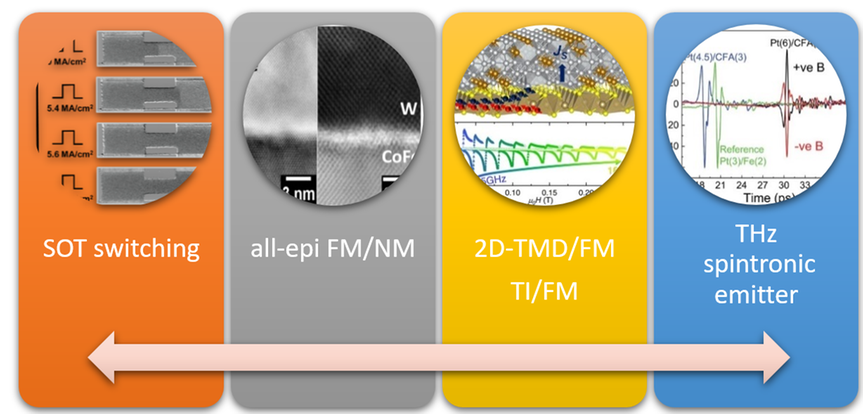Magnetic heterostructures optimized for spin-orbit torque magnetization switching and terahertz emission

The basis of the research is summarised in the figure on this page.
Forskningsprojektet studerar vi magnetiska heterostrukturer som består av nya kombinationer av ferromagnetiska (FM) och icke-magnetiska (NM) material med hög spinn-orbitalkoppling (SOC).
The project
In this research project we are studying magnetic heterostructures consisting of novel combinations of ferromagnetic (FM) and non-magnetic (NM) high spin-orbit coupling (SOC) materials. The focus is transfer of spin angular momentum across the heterostructure interfaces, which are optimized for spin-orbit torque switching of the magnetization and generation of terahertz (THz) radiation in spintronic emitters. Recent results obtained by us show that all-epitaxial (all-epi) heterostructures involving 5d heavy metals as the NM layer may yield giant transfer of spin angular momentum across the interface when a charge current is passed through the NM layer.
The results indicate the importance of considering the electronic band structure at the interface in the quest for optimizing the heterostructure properties for device applications. Two-dimensional (2D) transition-metal dichalcogenides (TMDs) constitute another novel choice of NM. Unlike graphene, which exhibits negligible SOC, it has been shown that TMDs can provide the necessary large SOC. Another benefit of TMDs is their layered characteristics with layers held together with weak van der Waals (vdW) interactions that can provide atomically sharp interfaces. Some of these materials exhibit FM properties, providing the possibility to build all-vdW magnetic heterostructures, which can further enhance the efficiency of spin angular momentum transfer across the interface. Topological insulators (TI) with strong SOC and spin-momentum-locked Dirac surface states have been predicted to be efficient for charge to spin conversion and is another NM material studied within this research. The foundation of the research is summarized in the figure below.
The basis of the research is summarised in the figure on this page.
